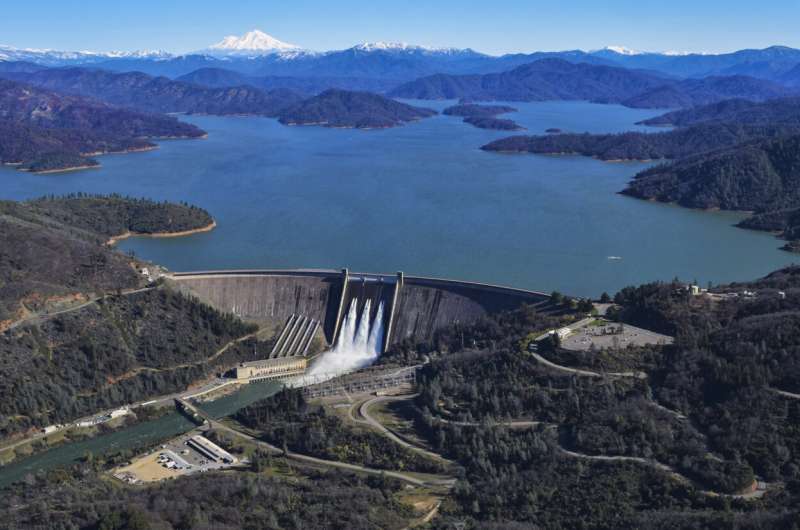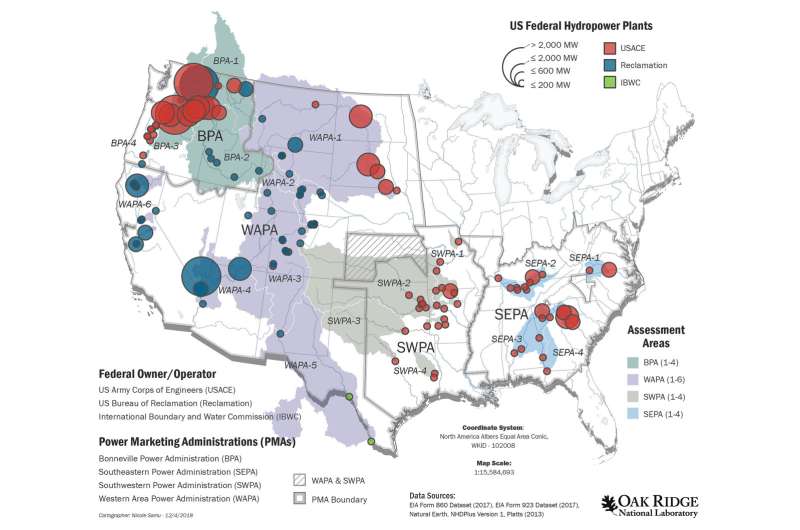New report seeks to ensure hydropower sustainability amid climate change

The U.S. Department of Energy's Oak Ridge National Laboratory has provided hydropower operators with new data to better prepare for extreme weather events and shifts in seasonal energy demands caused by climate change.
For the new report, ORNL researchers used downscaled global climate projections to simulate future hydrologic conditions at 132 federal hydropower facilities across the United States. The resulting projections will enable hydropower operators and policymakers to plan for changing climate conditions and reduced water availability by shifting their operational schedules and their use of water each season as part of an overall mitigation strategy.
"The intensification of future extreme events, including both floods and droughts, is one of the most critical issues threatening the resilience of U.S. hydropower systems and infrastructure," said Shih-Chieh Kao, water power program manager at ORNL. "This new normal requires us to think differently about current operational practices to adapt to a changing climate."
In addition to extreme events, a growing conflict in water availability versus energy demand is another challenge for hydropower operators. An earlier-than-expected snowmelt season in the western United States is likely to impact water runoff. This may result in less water for hydropower generation in the summer months, just as energy demand grows. Increased evaporation because of rising temperatures is also putting a strain on water needed for flood control, navigation, municipal water supplies and industrial and agricultural use.
Better understanding of these changes is important to future energy planning. Hydropower provides 35% of renewable energy and nearly 7% of all electricity produced in the U.S.
ORNL worked with DOE's Water Power Technologies Office and other federal agencies, building on two rounds of previous hydroclimate assessments conducted over the past 10 years. The study focused solely on federal hydropower facilities, which make up about half of all U.S. hydropower capacity and provide a variety of nonpower services to the community. Marketed by DOE Power Marketing Administrations, the energy produced at these facilities is sold primarily to public power utilities and rural electric cooperatives in 33 U.S. states.
Insights built on data
The study was rooted in regularly updated global climate projections from the Coupled Model Intercomparison Project, which supports periodic studies by the Intergovernmental Panel on Climate Change. However, to best downscale climate signals for each watershed, researchers had to consider characteristics unique to each facility and location.
From 2010 to 2013, ORNL researchers collected a variety of data on observed and simulated climate events, historical generation of hydropower plants, and watershed and land surface features unique to each region. The research team used this data to develop an assessment framework that could project water availability for hydropower operation by simulating a variety of hydrologic conditions, including annual and seasonal air temperatures, precipitation, runoff from melting snow or rain, and levels of drought.

From 2014 to 2017, the team focused on how changes in climate might impact hydropower generation from month to month and across seasons. This enhancement provided key data and projections that enabled hydropower operators to evaluate current operational practices with a focus on climate adaptation.
In the most recent iteration, from 2018 to 2022, ORNL developed a multimodal assessment framework to better reveal uncertainty and variability in future hydropower projections across regions. Pacific Northwest National Laboratory and Texas A&M University collaborated with ORNL on this phase of the project.
By using a suite of numerical models and statistical methods, researchers downscaled global climate change signals into future hydrologic and hydropower projections at each watershed location. Each assessment included simulations of future streamflow, hydropower operations and reservoir evaporation. Based on these simulations, researchers also estimated future energy demand affected by changing climate conditions.
Balancing water availability with water management
To sustain the benefits of hydropower as a renewable energy source, flexibility will be key, and these models provide a state-by-state roadmap for long-term planning.
To provide more hydropower stakeholders with the tools and data they need to plan for climate change impacts, DOE is extending its research to non-federal hydropower facilities, whose operators may not have the resources to study and address these challenges.
"The climate system is complex," said Kao, "but we can now incorporate increasingly more precise predictive models to understand potential shifts in climate extremes and determine what can be done to mitigate these changes."
More information: Report: hydroshare.ornl.gov/files/9505 … Y22_Final_Report.pdf


















